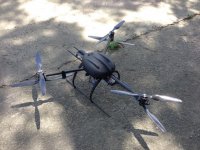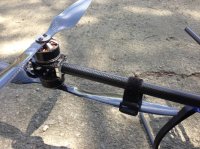Just did a motor failure redundancy test on my newly build Y6. Test 1 failed upper motor with everything went fine, copter in total control. However, in test 2 when I failed one of the lower motors, the copter went into self-spin and unable to be stopped even with full rudder input, resulting in inability to keep orientation if under FPV. Big thumb down.
Here are the links to the two test videos:
Test 1:
Test 2:
Is anybody able to give an explanation and possible solution to this? I wonder if it's the FC I used that caused the phenomenon, as the difference is huge...
Details:
Y6 300mm arm length
1550 carbon props
DJI WKM
Here are the links to the two test videos:
Test 1:
Test 2:
Is anybody able to give an explanation and possible solution to this? I wonder if it's the FC I used that caused the phenomenon, as the difference is huge...
Details:
Y6 300mm arm length
1550 carbon props
DJI WKM
Last edited by a moderator:


